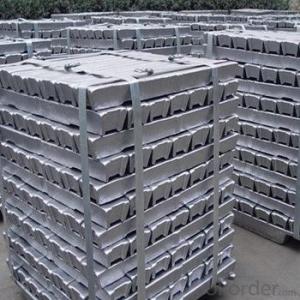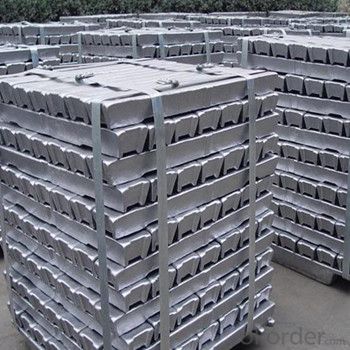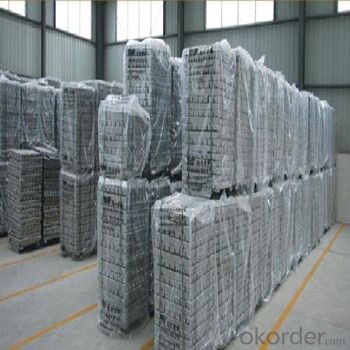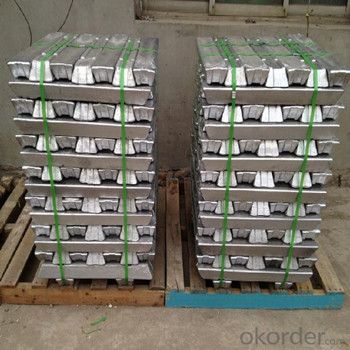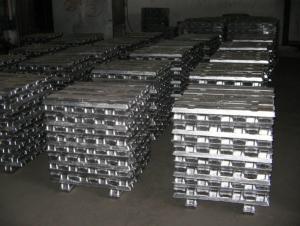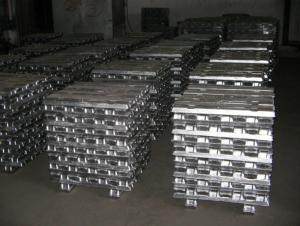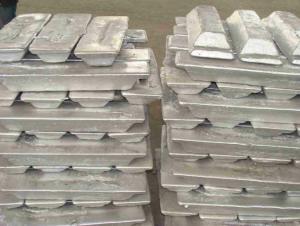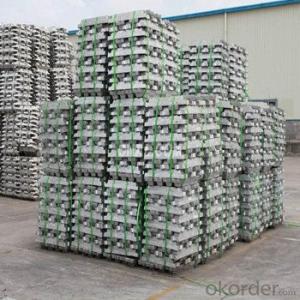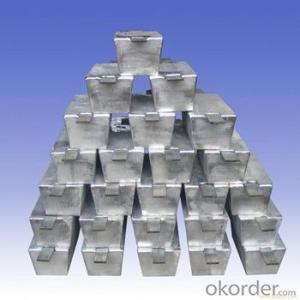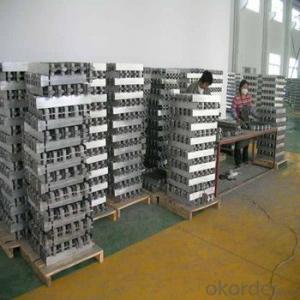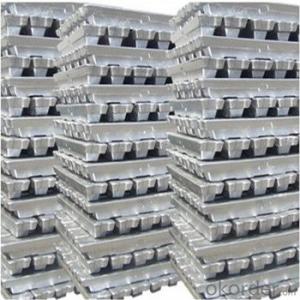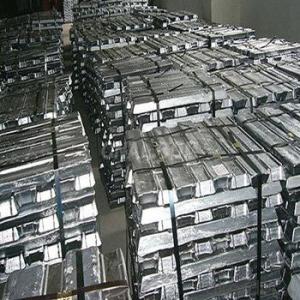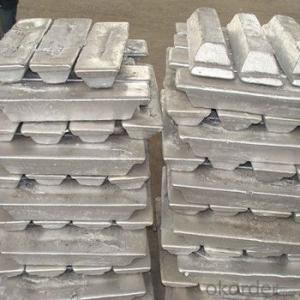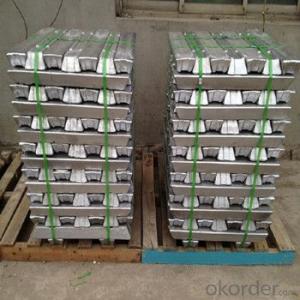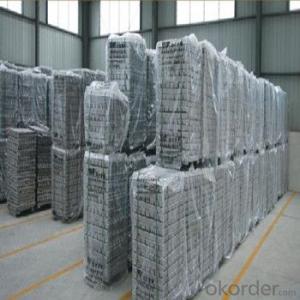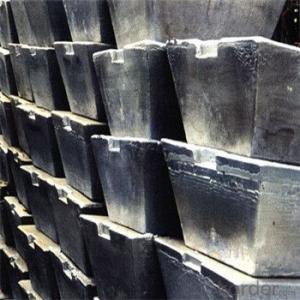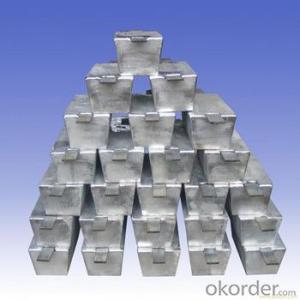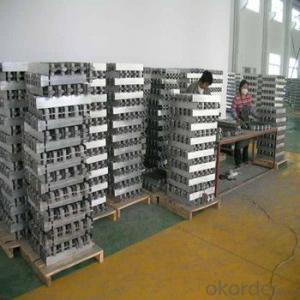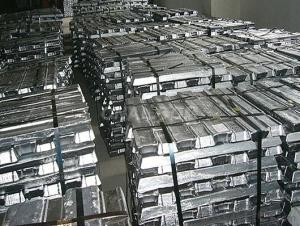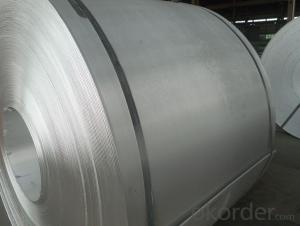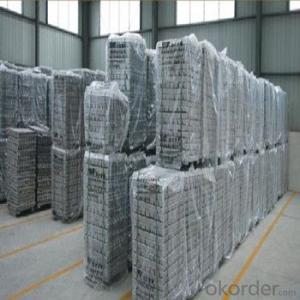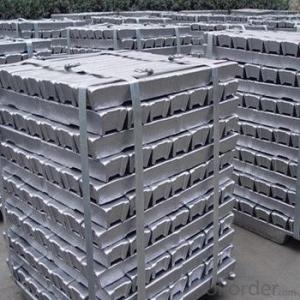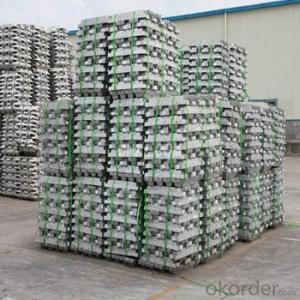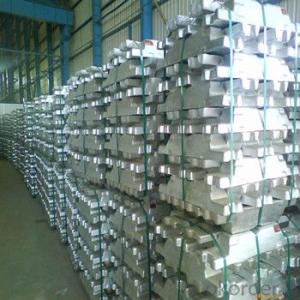Aluminum Pig/Ingot With High Quality And Hight Purity
- Loading Port:
- China main port
- Payment Terms:
- TT OR LC
- Min Order Qty:
- 1000 m.t.
- Supply Capability:
- 100000 m.t./month
OKorder Service Pledge
OKorder Financial Service
You Might Also Like
Pure Aluminum Pig/Ingot Used for Industry
1.Structure of Aluminum Pig/Ingot
A material that has been cast into a shape in order to be transported and processed easier than in an unprocessed form. An ingot is typically rectangular in shape, which allows it to be stacked. Ingots are most commonly associated with metals, with ingots of gold held in the vaults of banks and brokerages being popular images.
Aluminum Ingot is with the AL as the main chemical composition.Aluminum Ingot is used for industry,such as automobile,pinning and weaving,electron broadly and so on. Aluminum Ingot has the following advantages: easy control and operation, fast melting.
2.Main Features of the Aluminum Pig/Ingot
•High Purity
•Easy control and operation
•High strength
•Fast melting
•Competitive price
•Best Service
3.Aluminum Pig/Ingot Images
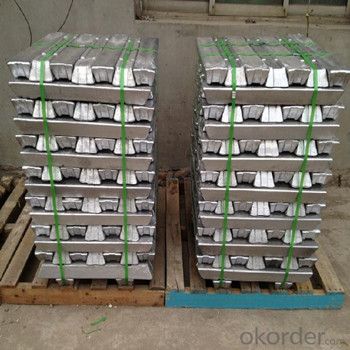
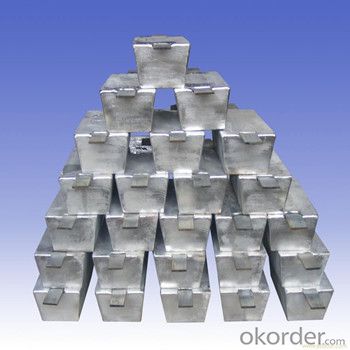
4.Aluminum Pig/Ingot Specification
Grade | Chemical Composition % | |||||||||
Al≥ | impurities ≤ | |||||||||
Si | Fe | Cu | Ga | Mg | Zn | Mn | others | Sum | ||
Al99.9 | 99.90 | 0.50 | 0.07 | 0.005 | 0.02 | 0.01 | 0.025 | - | 0.010 | 0.10 |
Al99.85 | 99.85 | 0.80 | 0.12 | 0.005 | 0.03 | 0.02 | 0.030 | - | 0.015 | 0.15 |
Al99.7 | 99.70 | 0.10 | 0.20 | 0.010 | 0.03 | 0.02 | 0.030 | - | 0.030 | 0.30 |
Al99.6 | 99.60 | 0.16 | 0.25 | 0.010 | 0.03 | 0.03 | 0.030 | - | 0.030 | 0.40 |
Al99.5 | 99.50 | 0.22 | 0.30 | 0.020 | 0.03 | 0.05 | 0.050 | - | 0.030 | 0.50 |
Al99.00 | 99.00 | 0.42 | 0.50 | 0.020 | 0.03 | 0.05 | 0.050 | - | 0.050 | 1.00 |
5.FAQ of Aluminum Pig/Ingot
We have organized several common questions for our clients,may help you sincerely:
①How about your company?
A reliable manufacturer & supplier of Aluminum Pig/Ingot,with many years’ experience in producing Aluminum Pig/Ingot.The items have beedn exported around the world,and have been acceptable among the customers,and have gotten the good reputation already.No matter from the quality,price and service,can be guaranteed for the cusgtomers.High purity and diffent grade are available.
②How to guarantee the quality of the products?
We have established the international advanced quality management system,every link from raw material to final product we have strict quality test;We resolutely put an end to unqualified products flowing into the market. At the same time, we will provide necessary follow-up service assurance.
③How long can we receive the product after purchase?
In the purchase of product within three wo We have organized several common questions for our clients,may help you sincerely:
- Q: Where can I get aluminium ingots in cans?
- Although aluminum prices now have to rise, but now is high, a large number of aluminum ingots, and some hot money funds customs Tun once sold, small is the crowning calamity. Cautious.
- Q: How are aluminum ingots used in the production of building facades?
- The production of building facades heavily relies on the essential properties and versatility of aluminum ingots. These ingots enable the creation of lightweight, durable, and aesthetically pleasing facades in modern architecture. To begin, aluminum ingots are melted and cast into various shapes and sizes according to the specific design requirements of the building facade. This casting process ensures that the aluminum can be easily manipulated and fabricated into different facade components. Once cast, the ingots can be extruded or rolled into sheets, panels, or profiles. These aluminum sheets or panels are then cut, shaped, and assembled to achieve the desired facade design. The malleability of aluminum allows for intricate designs and customization options, enabling architects to bring their creative visions to life. One of the major advantages of aluminum ingots in building facades is their lightweight nature. With a low density, aluminum is significantly lighter than other metals like steel. This characteristic reduces the overall weight of the facade, making installation easier and decreasing the load on the building structure. Moreover, the lightweight property of aluminum facilitates the creation of larger and more expansive facade designs, opening up greater design possibilities. Furthermore, aluminum ingots possess excellent corrosion resistance, a crucial attribute for building facades exposed to different weather conditions. The natural oxide layer that forms on the surface of aluminum protects it from rust and corrosion, ensuring the facade's longevity and durability. This resistance to corrosion reduces maintenance costs and extends the lifespan of the building facade. Additionally, aluminum ingots offer high thermal conductivity, which plays a significant role in effective thermal management for building facades. By helping regulate temperature and reducing energy consumption, aluminum facades contribute to sustainable building practices. These facades can also incorporate insulation materials to enhance energy efficiency. In terms of aesthetics, aluminum ingots provide a wide range of finishing options. They can be anodized, painted, or coated in various colors and textures to achieve the desired appearance. Aluminum facades can also be combined with other materials like glass or stone to create visually striking and modern facades that enhance the overall architectural design. In conclusion, the extensive use of aluminum ingots in building facades is due to their lightweight nature, corrosion resistance, thermal conductivity, and design versatility. These properties empower architects and designers to create durable, energy-efficient, and visually appealing facades that align with modern architectural trends.
- Q: What are the benefits of using aluminum ingots in the construction of lightweight structures?
- The benefits of using aluminum ingots in the construction of lightweight structures include their excellent strength-to-weight ratio, corrosion resistance, and recyclability. Aluminum is a lightweight metal that offers high strength, allowing for the creation of sturdy structures with reduced weight. Its corrosion resistance ensures durability and longevity, especially in outdoor applications. Additionally, aluminum is highly recyclable, making it an environmentally friendly choice.
- Q: Can aluminum ingots be customized for specific applications?
- Yes, aluminum ingots can be customized for specific applications. Aluminum is a highly versatile metal that can be easily manipulated to meet various requirements. The customization process typically involves alloying the aluminum with other elements to enhance its properties such as strength, hardness, corrosion resistance, and thermal conductivity. Additionally, the ingots can be subjected to various heat treatment processes like annealing, quenching, and tempering to further modify their properties. This allows for the production of aluminum ingots that are tailored to specific applications, ranging from automotive parts and aerospace components to construction materials and consumer products.
- Q: What are the properties of aluminum ingots?
- Aluminum ingots possess a range of distinct properties that render them highly valuable across numerous industries. Primarily, aluminum ingots demonstrate exceptional lightness due to their low density in comparison to other metals. This characteristic proves ideal for sectors such as aerospace and automotive where weight reduction is crucial. Furthermore, aluminum ingots showcase excellent resistance to corrosion, rendering them suitable for environments where exposure to moisture, chemicals, or harsh weather conditions is likely. This resistance is a result of the formation of a thin, protective oxide layer on the surface of the ingot, effectively preventing further oxidation and deterioration. Another notable property of aluminum ingots is their high thermal conductivity, allowing for efficient heat transfer. This attribute proves particularly advantageous in heat exchange systems, where the ingots facilitate the transfer of thermal energy. Additionally, aluminum ingots also exhibit excellent electrical conductivity, making them well-suited for applications within the electrical and electronics industries. Moreover, aluminum ingots possess a high strength-to-weight ratio, providing strength while remaining lightweight. This property enables the construction of structures that require both durability and strength without compromising on weight. Additionally, aluminum ingots are easily recyclable, maintaining their properties even after undergoing multiple recycling processes, making them an environmentally friendly choice. In summary, the properties of aluminum ingots, including their lightness, corrosion resistance, thermal and electrical conductivity, high strength-to-weight ratio, and recyclability, contribute to their widespread utilization across various industries. These industries range from transportation and construction to packaging and consumer goods.
- Q: How about aluminium material?
- Connaught scale is still OK, belong to cutting-edge, old trees send new shoots, they are from the aluminum out, the bird's nest is responsible for aluminum
- Q: 15% of the iron in the ingot represents 1 tons of iron
- In particular, two pollution shall be avoided when dealing with wastes, and harmful and harmful wastes shall be guaranteed not to cause harm to humans. It is necessary to formulate a comprehensive and comprehensive treatment plan for solid waste produced by the city. Comprehensive treatment is aimed at all kinds of waste in the city to a certain place, according to the characteristics of solid waste, the waste treatment process are combined into a system, so as to make reasonable use of the various concentration of material and energy. Through comprehensive treatment can effectively reduce the final disposal of waste, waste emissions, reduce the area of environmental pollution, to prevent the spread of contamination two times, while still being a total processing of low cost, high resource utilization efficiency.
- Q: How are aluminum ingots used in the automotive industry?
- The automotive industry relies heavily on aluminum ingots, which are widely utilized in the manufacturing of various vehicle components. Engine blocks, for instance, are primarily produced using aluminum ingots due to their lightweight nature. This characteristic reduces the overall weight of the vehicle, thereby enhancing fuel efficiency and performance. Moreover, aluminum ingots are crucial for the production of wheels, transmission cases, cylinder heads, and other essential car parts. The high strength-to-weight ratio of aluminum makes it the preferred choice for these components, ensuring durability and enhancing overall safety. Furthermore, aluminum ingots are utilized in the construction of car body panels, including hoods, doors, and trunk lids. These aluminum panels significantly reduce weight compared to traditional steel panels, resulting in improved energy efficiency and handling. Additionally, aluminum's excellent corrosion resistance properties extend the longevity of these body panels. In recent years, the demand for electric vehicles (EVs) has grown, further highlighting the significance of aluminum ingots in the automotive industry. EVs require lightweight materials to offset the weight of battery packs, and aluminum ingots provide an ideal solution. The use of aluminum in EVs not only increases driving range but also enhances battery life and overall performance. To sum up, the automotive industry relies heavily on aluminum ingots for their lightweight nature, strength, and corrosion resistance properties. These ingots are vital components in engine blocks, transmission cases, wheels, body panels, and other critical parts, contributing to improved fuel efficiency, safety, and performance of vehicles.
- Q: Want to know the difference between ZL101 and A356 aluminium ingots?
- I know. I used to work on aluminum alloy casting, and these two materials are suitable for gravity castingThe difference between different grades: in fact, ZL101 is Chinese Aluminum Alloy grade, and A356 is the main element of Aluminum Alloy grades, their composition is very close to so in the Aluminum Alloy foundry industry also regarded as a kind of alloy ingot.
- Q: How are aluminum ingots used in the production of railway components?
- Due to their unique properties and benefits, aluminum ingots play a crucial role in the production of railway components. They are melted down and serve as raw material for manufacturing various railway parts. One major use of aluminum ingots in railway components is seen in the construction of lightweight yet durable train bodies. The high strength-to-weight ratio of aluminum makes it an ideal material for building train carriages and panels. By utilizing aluminum ingots, manufacturers can create lightweight structures that are easier to transport and require less energy to operate. This not only reduces fuel consumption but also contributes to a more sustainable and eco-friendly transportation system. Furthermore, aluminum ingots are utilized in producing other railway components like doors, windows, and flooring. These components need to possess strength, resistance to corrosion, and the ability to withstand harsh environmental conditions encountered in railway operations. Aluminum, being highly resistant to corrosion, offers exceptional protection against weathering, ensuring the longevity and reliability of these components. In addition, aluminum ingots find application in the production of electrical components for railways. Aluminum's excellent electrical conductivity makes it suitable for manufacturing overhead power lines, conductor rails, and electrical connectors. These components are vital for ensuring efficient power transmission and distribution throughout the railway system. To conclude, aluminum ingots are vital for the production of railway components. Their lightweight nature, strength, corrosion resistance, and electrical conductivity make them ideal for manufacturing train bodies, doors, windows, flooring, and electrical components. By utilizing aluminum ingots, the railway industry can achieve improved efficiency, durability, and sustainability in their operations.
Send your message to us
Aluminum Pig/Ingot With High Quality And Hight Purity
- Loading Port:
- China main port
- Payment Terms:
- TT OR LC
- Min Order Qty:
- 1000 m.t.
- Supply Capability:
- 100000 m.t./month
OKorder Service Pledge
OKorder Financial Service
Similar products
Hot products
Hot Searches
Related keywords
